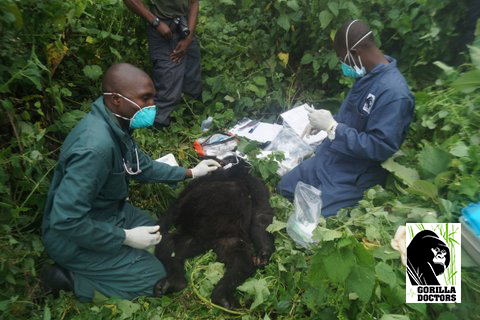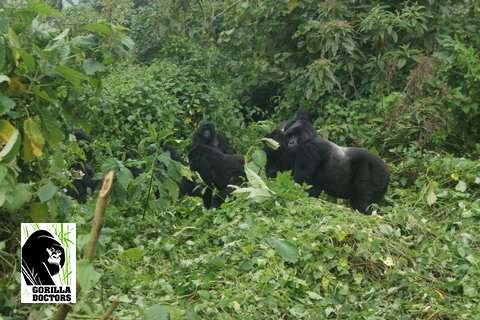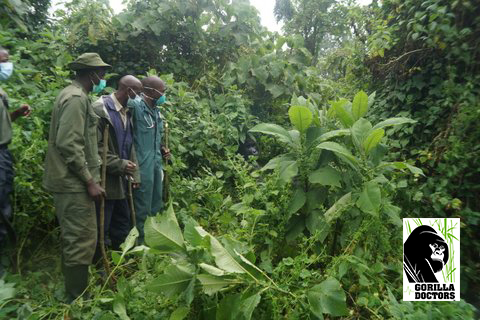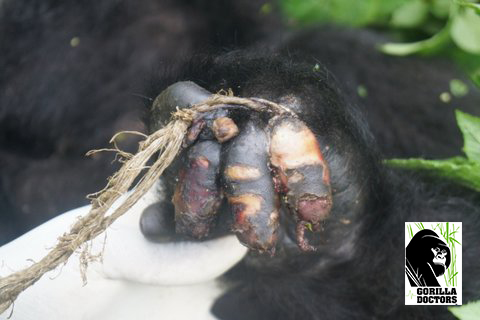Gorilla Doctors treat severe snare injury in a juvenile mountain gorilla in Virunga National Park
By Gorilla Doctors Staff on Wednesday, June 22nd, 2016 in Blog.
Note: The bottom of this post has a somewhat graphic photo of the snare and its wounds.
By Joost Pilippa
Last week, Dr. Eddy received a phone call that Mutangazi, a juvenile male mountain gorilla, was caught in a snare in the Mikeno sector of Virunga National Park, in the Democratic Republic of Congo (DRC). Earlier that same day, trackers were successful in cutting the snare at the tree end, and although it was difficulty to see, they believed Mutangazi had removed the rope snare once the tension was off.
Regrettably, the next day it was clear that the snare was still tight around Mutangazi’s fingers. So I drove over to DRC at 4 a.m. the next morning to join the Gorilla Doctors team (Drs. Eddy, Martin, myself, as well as numerous ICCN trackers and rangers to intervene.
Mutangazi’s family, the Bageni group, had been observed the afternoon before the intervention, so we knew approximately where they were. On the day of the intervention, we hiked for a good three-and-a-half hours before we got to the Gasata Gorge where the group was. That’s when 16 gorillas from the group, including Mutangazi, decided to cross the gorge using a tree. The others climbed up the slope.
We were not agile enough to use the tree, so our team had to go down the steep slope of the gorge and climb back up on the other side. This extra hiking took a bit of time – especially in my case. Once on the other side of the gorge, the Bageni group settled down to eat in a relatively open location, so we started preparing for the intervention to treat Mutangazi’s wounds.
 Dr. Eddy anesthetized Mutangazi with a dart, after which silverback Bageni moved over to look after the juvenile. Other juveniles were intrigued by Mutangazi suddenly falling asleep, and also came over to investigate. With slow, coordinated movement, trackers were able to separate Mutangazi from the rest of the group so that we could start the procedure.
Dr. Eddy anesthetized Mutangazi with a dart, after which silverback Bageni moved over to look after the juvenile. Other juveniles were intrigued by Mutangazi suddenly falling asleep, and also came over to investigate. With slow, coordinated movement, trackers were able to separate Mutangazi from the rest of the group so that we could start the procedure.
The whole group stayed nearby, and watched us throughout the whole intervention. The trackers and rangers quietly formed a safe barrier between us and the group.
We discovered that the nylon rope was wrapped extremely tightly around Mutangazi’s fingers, which had severely restricted the blood flow to his fingertips – , so much so that the fingertips were essentially devitalized. Unfortunately, we had to amputate several fingertips in order to protect Mutungazi from severe infection and hasten his recovery.
Throughout the procedure, Dr. Eddy monitored the anesthesia carefully, and Dr. Martin collected valuable samples for a full health assessment and future research. It is wonderful to work with such dedicated and skilled colleagues, especially under strenuous conditions in the forest.
After we were done, we reversed the anesthesia, and retreated a few meters. As soon as Mutangazi woke and stood up, the whole group, which had been watching from the nearby bushes, came to see him.

Mivumbi, his mother, dropped her younger baby off for silverback Bageni to look after and immediately carried Mutangazi on her back to comfort him. Soon after, she took him off her back and the whole group came over to inspect the sutures on his fingers. It was heartwarming and an amazing scene to witness – a very emotional moment.
Despite everyone wanting to stay and watch this breathtaking scene for longer, we still had a long way to go back, and so we packed up and left, leaving a group of rangers to continue monitoring the group.
Snares are set out in the forest by poachers to catch animals for bushmeat. The snares are not usually targeting gorillas specifically, but gorillas are “bycatch” in many instances. There are snare removal teams that remove hundreds of snares in DRC, Uganda and Rwanda every year, and yet Gorilla Doctors teams are still called in on emergency too often to remove these debilitating snares from mountain gorillas’ limbs in the three countries where we work.
Snare photo below:



 Donate
Donate